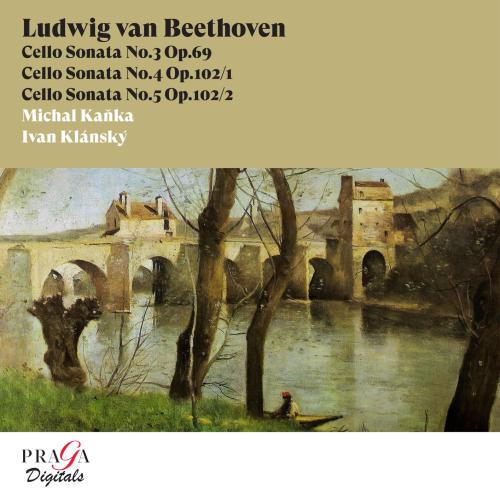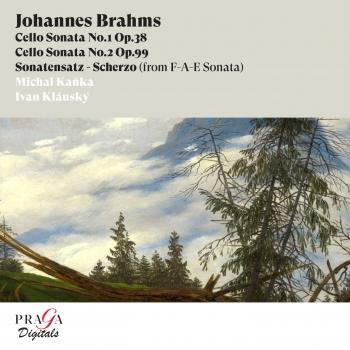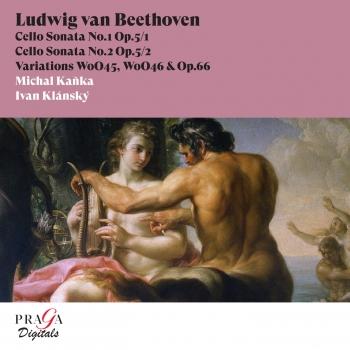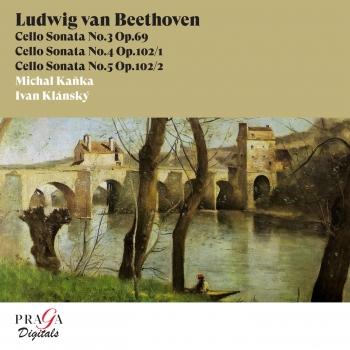
Ludwig van Beethoven: Cello Sonatas, Op. 69 & Op. 102 Michal Kanka & Ivan Klánský
Album Info
Album Veröffentlichung:
2023
HRA-Veröffentlichung:
10.02.2023
Label: Praga Digitals
Genre: Classical
Subgenre: Chamber Music
Interpret: Michal Kanka & Ivan Klánský
Komponist: Ludwig van Beethoven (1770–1827)
Das Album enthält Albumcover Booklet (PDF)
- Ludwig van Beethoven (1770 - 1827): Cello Sonata No. 3 in A Major, Op. 69:
- 1 Beethoven: Cello Sonata No. 3 in A Major, Op. 69: I. Allegro ma non tanto 13:04
- 2 Beethoven: Cello Sonata No. 3 in A Major, Op. 69: II. Scherzo. Allegro molto 05:00
- 3 Beethoven: Cello Sonata No. 3 in A Major, Op. 69: III. Adagio cantabile - Allegro vivace 09:09
- Cello Sonata No. 4 in C Major, Op. 102 No. 1:
- 4 Beethoven: Cello Sonata No. 4 in C Major, Op. 102 No. 1: I. Andante - Allegro vivace 08:19
- 5 Beethoven: Cello Sonata No. 4 in C Major, Op. 102 No. 1: II. Adagio - Tempo d'Andante - Allegro vivace 07:23
- Cello Sonata No. 5 in D Major, Op. 102 No. 2:
- 6 Beethoven: Cello Sonata No. 5 in D Major, Op. 102 No. 2: I. Allegro con brio 06:51
- 7 Beethoven: Cello Sonata No. 5 in D Major, Op. 102 No. 2: II. Adagio con molto sentimento d'affetto - attacca 08:07
- 8 Beethoven: Cello Sonata No. 5 in D Major, Op. 102 No. 2: III. Allegro - Allegro fugato 04:15
Info zu Ludwig van Beethoven: Cello Sonatas, Op. 69 & Op. 102
Eight years after the publication of his first cello sonatas (Op. 5), Beethoven embarked on the writing of his Third Sonata. This luminous Sonata in A major Op. 69 is a pinnacle of Beethoven’s chamber music, then in full possession of his faculties. The first movement, written in sonata form, is the fullest and most characteristic. The slow movement is very short and shows a very ‘Beethovenian character’ (original syncopations, trio based on a theme reduced to two notes, 'vibrato' effects required of the keyboard, unprecedented feeling of introversion), the third ends in a somewhat decorative style. Typical of the ‘second manner’ of a Beethoven in full possession of his faculties, it was composed in the exceptional period which saw the birth of the Coriolan Overture, the Fifth Symphony and the Pastoral Symphony. The two Sonata Op. 102 were composed in 1815 and published in 1817.
These two masterpieces belong to the composer’s last ‘manner’, a period of illness and difficulties of all kinds that Beethoven was going through at the time. These sonatas astonish by their spareness at a time when the duo concertante, virtuoso and fanciful was fashionable in France and Italy; Beethoven freed himself more and more from classical forms by marking the mention ‘Freie Sonata’ (Free Sonata) at the head of his Sonata in C major. The last sonata, No. 5, is rough and prefigures the whole modern history of the Sonata; the two partners, in equal shares, dialogue in complete independence, and at times, foreshadow the writing style of the 20th century when they soliloquize, almost ignoring each other. These last two sonatas strike by the complexity of their writing, but above all by their visionary character.
Michal Kaňka,
Michal Kaňka
Geboren in Prag in 1960, begann Michal Kaňka als 7-jähriger, unter Leitung von Mirko Škampa, Violoncello zu spielen. Später, am Konservatorium in Prag, war er Student von Prof. Viktor Moučka (Mitglied des Vlach Streichquartetts). Während seinem Studium an der Prager Akademie der Musikalischen Künste – in Klasse von Prof. J. Chuchro – nahm er in 1983 und 1984 am Gregor Piatigorsky Seminar in Los Angeles unter Führung von Andre Navarra, Maurice Gendron und Paul Tortelier teil.
Im Jahre 1980 war Michal Kaňka bei dem Internationalen Wettbewerb des Prager Frühlings mit dem Ehrenpreis bewertet. Ein Jahr später gewann er den Grand prix in allen Kategorien im Rahmen des Tschechoslowakischen Nationalwettbewerbes. Nach den ersten Erfolgen folgten die höchsten Preise im Tschaikowsky Cello Wettbewerb in Moskau in 1982 (Laureat) und im Prager Frühling Wettbewerb in 1983 (erster Preis). In 1986 gewann Michal den Internationalen ARD Wettbewerb in München.
Michal Kaňka tritt mit bedeutenden internationalen Orchestern auf. U. a. mit der Tschechischen Philharmonie, mit dem Bayerischen Rundfunk Orch., mit Rundfunk Berlin Och., mit Slovak Philharmonie, Lausanne und Prag Kammerorchestern, mit vielen Orchestern in Japan. Er war ein nominierter Solist der Staatsphilharmonie Brno zwischen Jahre 1995 und 2005 und zwischen 2003 und 2003 hatte er eine Ehrenposition als Solist des Rundfunkorchesters Prag.
Michal Kaňka hat viele Aufnahmen für Tschechischen Rundfunk, Radio France, Bayerischen Rundfunk, AVRO Holland… verwirklicht. Er hat auch eine große Menge (mehr als 40) von Solo CDs bei Supraphon, Panton, Bonton, Nuova Era (Italien) aufgenommen. Lange Jahre arbeitete er mit der Französischen Firma Praga Digitals (Distribution von Harmonia Mundi Frankreich) bei derer er circa 30 CD realisierte. Unter anderen: Boccherini – 7 Sonaten, Mysliveček – 6 Sonaten (Weltpremiere), Kodaly – Cello Kompositionen. Für diese Aufnahme hat er folgende Preise bekommen : Choc de la Musique, Diapason d´Or… Boccherini – Sonaten (Folge 2), Martinů – Cello Kleinwerke, Beethoven – Komplett von Sonaten und Variationen – wieder SCHOC de la Musique, Sonaten von A. Rubinstein, Haydn Cellokonzerte, Brahms Sonaten, Sonaten von Rachmaninov und Myaskovsky (diapason D´Or), Sonaten von C. Saint-Saëns, L. Boëllmann und C. Franck, M. Weinberg (COC du MOI). Weitere Aufnahmen in 2010 waren Sonaten von D. Schostakovich und Stücke für Cello und Klavier von E. Bloch. In 2011 – Strauss, Ravel und Tcherepnin. In 2012 – Cello Konzerten von Kraft, Vranicky und Stamitz (Supraphon)…Gerade jetzt (Juni 2015) ist seine neue CD bei der Japanischen Firma – Name Records „Cello Mosaic“ erschienen.
Michal Kaňka ist auch gesuchter Kammermusikspieler. Als Mitglied des Prazak Quartetts (seit 1986), tritt er an den wichtigsten Konzertpodien der Welt auf.
Seit 2011 unterrichtet er Cello-solo an der Hochschulle für Musik und Darstellende Kunst in Prag. Seit 2013 ist er Professor am Prager Konservatorium. Als Vorsitzender der permanenten Kommission des Internationalen Wettbewerbes Prager Frühling wirkt er seit 2014. Seit 2016 ist er tätig als Mitglied der Stiftung Bohuslav Martinu. Seit 2018 arbeitet er als Mitglied des künstlerischen Rats des Internationalen Festivals Prager Frühling.
Im April 2017 fing er eine Zusammenarbeit als Cellist des Wihan Streichquartetts an mit welchem schon 4 CD und bis jetzt über hundert Konzerte in Tschechischen Republik, Frankreich, England, Österreich, in der Schweiz, Slowakei und Japan gespielt hat.
Michal Kaňka spielt ein Französisches Cello von Christian Bayon 2006 und Französischen Bogen von Nicole Descloux 2000.
Booklet für Ludwig van Beethoven: Cello Sonatas, Op. 69 & Op. 102











